
 Image: Mark Hachman / IDG
Image: Mark Hachman / IDG
At a glance
Expert’s Rating
Pros
Gorgeous OLED screenSimply outstanding battery life5G option for mobile workTerrific inking experience, and the pen is includedDecent value
Cons
Poor performance in placesSlow, laggy SSDAlmost out of date
Our Verdict
Samsung’s Galaxy Book Pro 360 5G should appeal to a niche buyer searching for a connected, tablet-like PC with an excellent screen and battery life. Otherwise, you’ll probably find better options elsewhere.
Price When Reviewed
$1,399.99
Best Prices Today: Samsung Galaxy Book Pro 360 5G
RetailerPrice
Samsung’s Galaxy Book Pro 360 5G shouldn’t be considered by those looking for a general-purpose PC. But for someone who lives at a coffee shop, tapping out email, sneaking in a Netflix video, and shuttling back and forth? Keep reading.
This device is a tablet in laptop’s clothing, with a 5G connection and fabulous battery life that many of its competitors lack. Performance lags in places, though you’ll probably forget all about that while viewing the gorgeous OLED screen.
Keep in mind that this particular device is nearly a generation old. It’s still worth considering, as really only the 11th-gen processor lags behind the state-of-the-art 12th-gen Core hardware found within the Galaxy Book2 laptops Samsung recently announced. Still, view this device with a predator’s eye (aka watch for retailers who may be clearing out older inventory). If you’re the specific sort of customer who finds this review appealing, then snap it up.
Samsung Galaxy Book Pro 360 5G basic features
We’re reviewing the Galaxy Pro 360 5G, a specialized 360-degree convertible that ships only with a 13.3-inch display option, the Mystic Silver color scheme, and the integrated 5G radio. It ships in one of two configurations: one with a Core i5-1130G7 for $1,399.99 (or $1,249.99 on Samsung.com at press time) or a more expensive $1,599.99 version with a Core i7-1160G7. (At Samsung, that model is listed as out of stock). The Core i7 model also offers more memory (16GB RAM) as well as a larger SSD option (up to 512GB). We found the Core i7 version at Best Buy for $1,399.99 at press time. Keep in mind that while a laptop with 8GB of RAM and 256GB of storage is perfectly serviceable, the available discounts may make the upgrade worthwhile.
Both models ship with Samsung’s include S Pen for inking, which saves some money, though there’s no built-in holster. Otherwise, the unit we’re reviewing requires purchasing one of our recommended USB-C hubs to connect to devices with a legacy USB-A connector.
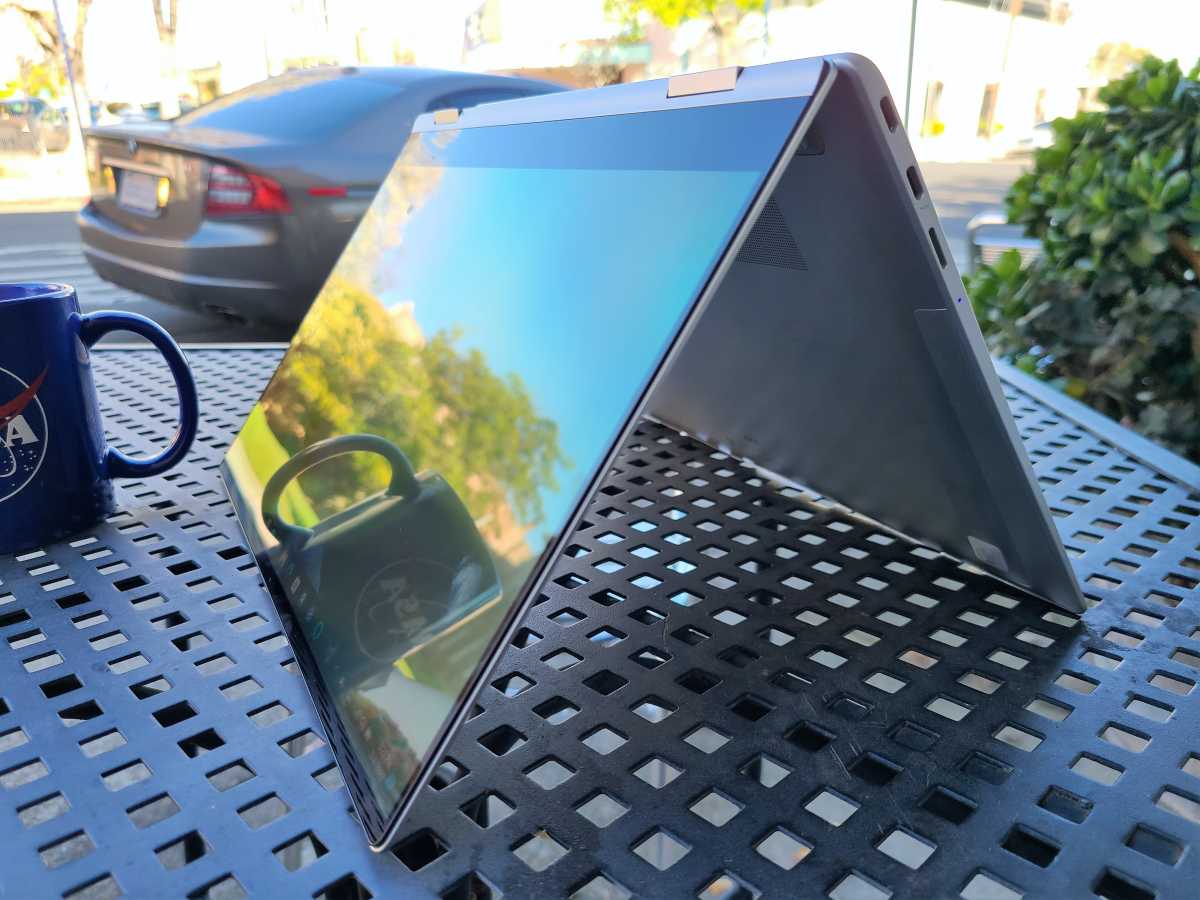
Mark Hachman / IDG
Mark Hachman / IDG
Mark Hachman / IDG
Samsung has numerous other options within its Galaxy Book lineup from which to choose, though the differences may be confusing.
Forgoing the 5G option opens up more choices. Samsung’s Galaxy Book Pro 360 (without 5G!) is available in either a 13.3-inch or a 15.6-inch form factor, and we reviewed one of the models last year with a Core i7 chip inside of it. This review unit has a slower Core i5, which allows us to provide a detailed comparison of the two notebooks in terms of performance and general usability.
Finally, remember that this laptop is a 360-degree convertible, rotating from a clamshell all the way around to a tablet mode. Otherwise, consider the similar Samsung Galaxy Book Pro, a traditional clamshell notebook that lacks both the S Pen as well as a touch display. The Book Pro also includes a USB Type A port.
If you’re thinking to yourself, hey, isn’t this the old one? — yes, you’re right. Samsung has recently launched its Galaxy Book2 lineup, which will ship soon. The importance of these laptops is that you’ll likely see these on discount as Samsung clears the decks for the new models.
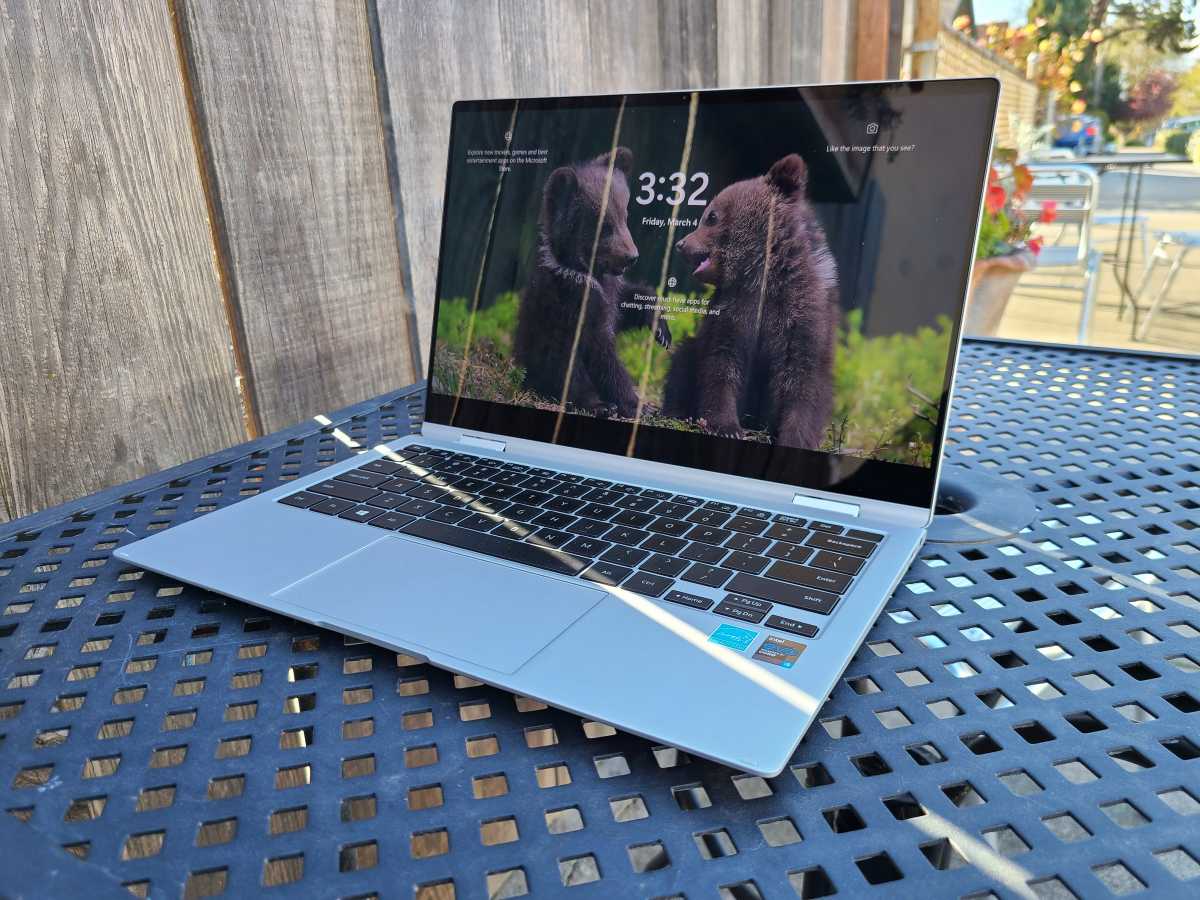
Mark Hachman / IDG
Mark Hachman / IDG
Mark Hachman / IDG
Processor: Intel Core i5-1130G7 / Core i7-1165G7 (Core i5 as tested)Display: 13.3-inch (1920×1080) Super AMOLED with touch, HDRMemory: 8GB/16GB LPDDR4x (8GB as tested)Storage: 256GB/512GB SSD (256 GB as tested)Graphics: Intel Iris XePorts: 1 USB-C (Thunderbolt 4); 2 USB-C, microSD, 3.5mm jack, Kensington lockSecurity: Fingerprint readerCamera: 720p (user-facing)Battery: 62.1Wh (design), 63.3Wh (reported)Wireless: WiFi 6E Gig+ (802.11ax), Bluetooth 5.1, 5G WWANOperating system: Windows 10 HomeDimensions: 11.91 x 7.95 x 0.45in.Weight: 3.06lb (rated)Colors: Mystic SilverPrices: $1,399.99 as tested, $1,249.99 after discount (Samsung.com)
My initial impression of the smaller 13-inch Galaxy Book Pro 360 5G was of just another silver laptop stamped with a small black Samsung logo on the rear of the display. While the Mystic Blue of the larger Pro 360 we reviewed last year sometimes felt like it was indistinguishable from black, it did offer a splash of color in the right light. Most silver 13-inch laptops in this category are actually Chromebooks and this slightly soured my initial impression.
Not entirely, however. One of the strengths of a 360-degree convertible Chromebook is its ability to swivel back on itself and create a “tablet” for Android apps. Now, Windows 11 can do the same. Add the laptop’s pen capabilities to that and a 360-degree Windows 11 convertible and the Book Pro 360 5G is more valuable than ever. The hinge rotated firmly and stably without flopping around, and the overall build quality feels solid if a bit heavy for a 13-inch notebook. There’s a tiny bit of flex with the display, but nothing worrisome.

Mark Hachman / IDG
Mark Hachman / IDG
Mark Hachman / IDG
Air is pulled in by a fine grille of holes underneath the chassis and pushed out back through then hinge vents. Four rubber pads hold the laptop slightly off the desk or table. The Pro 360 5G does get warm (though not hot) in the default “Optimized” setting, which adjusts fan speed and performance. The fan turned on noticeably with Whiteboard and Microsoft Edge running with just a hint of coil whine. Four fan modes are available (High Performance, No fan, Silent, and Optimized). The “Silent” mode, unfortunately, isn’t.
Different display types offer their own distinct advantages. Most high-refresh-rate laptops use IPS technology. Samsung’s OLED displays are a visual treat, with profoundly deep blacks and vibrant colors that help make this laptop a joy to watch videos on. There are a number of display modes to chose from, which slightly differ both in the standard Windows 11 settings as well as Samsung’s Settings app. The display puts out 281 nits, just above the 250-260 nits or so that we consider a suitable brightness.
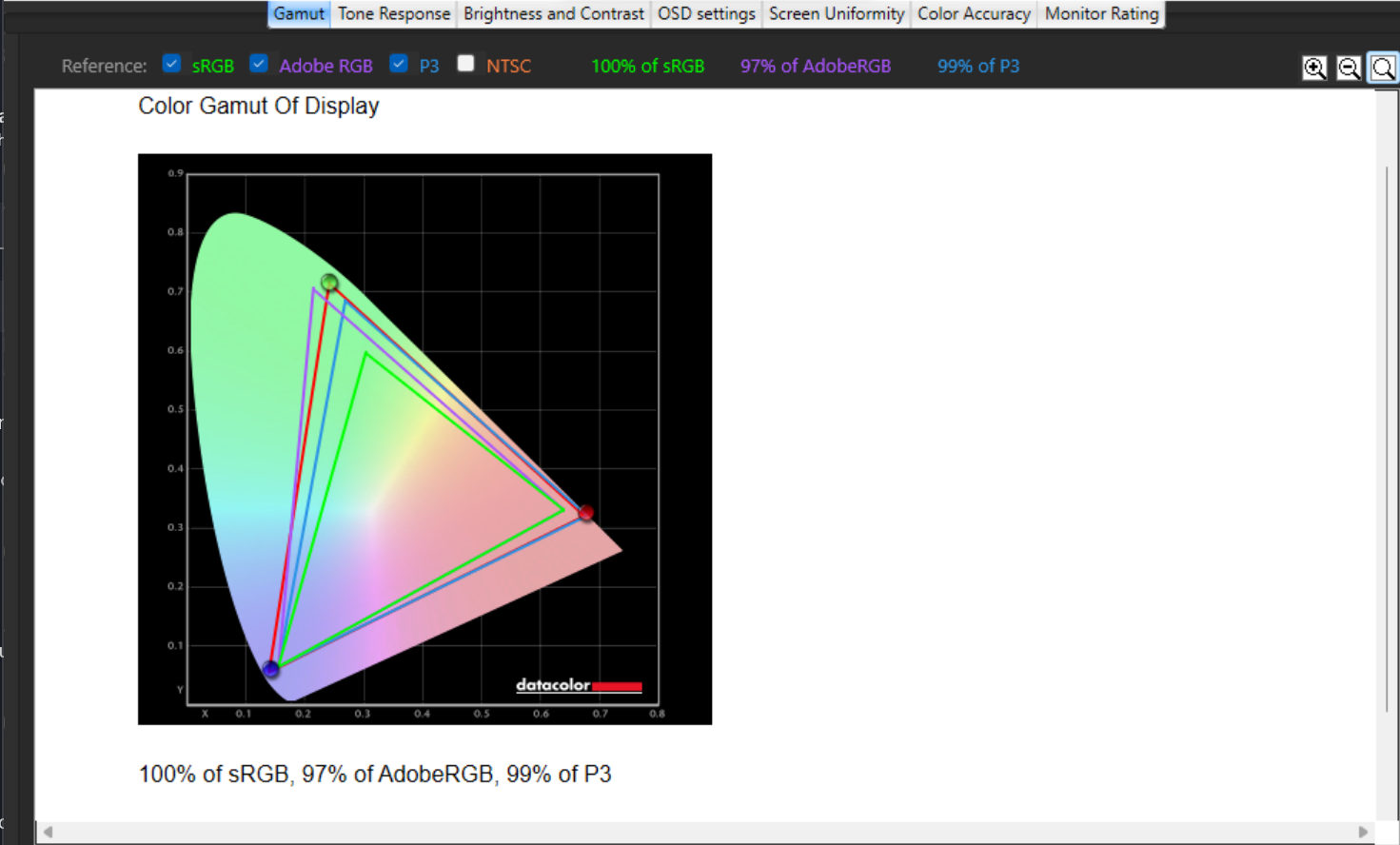
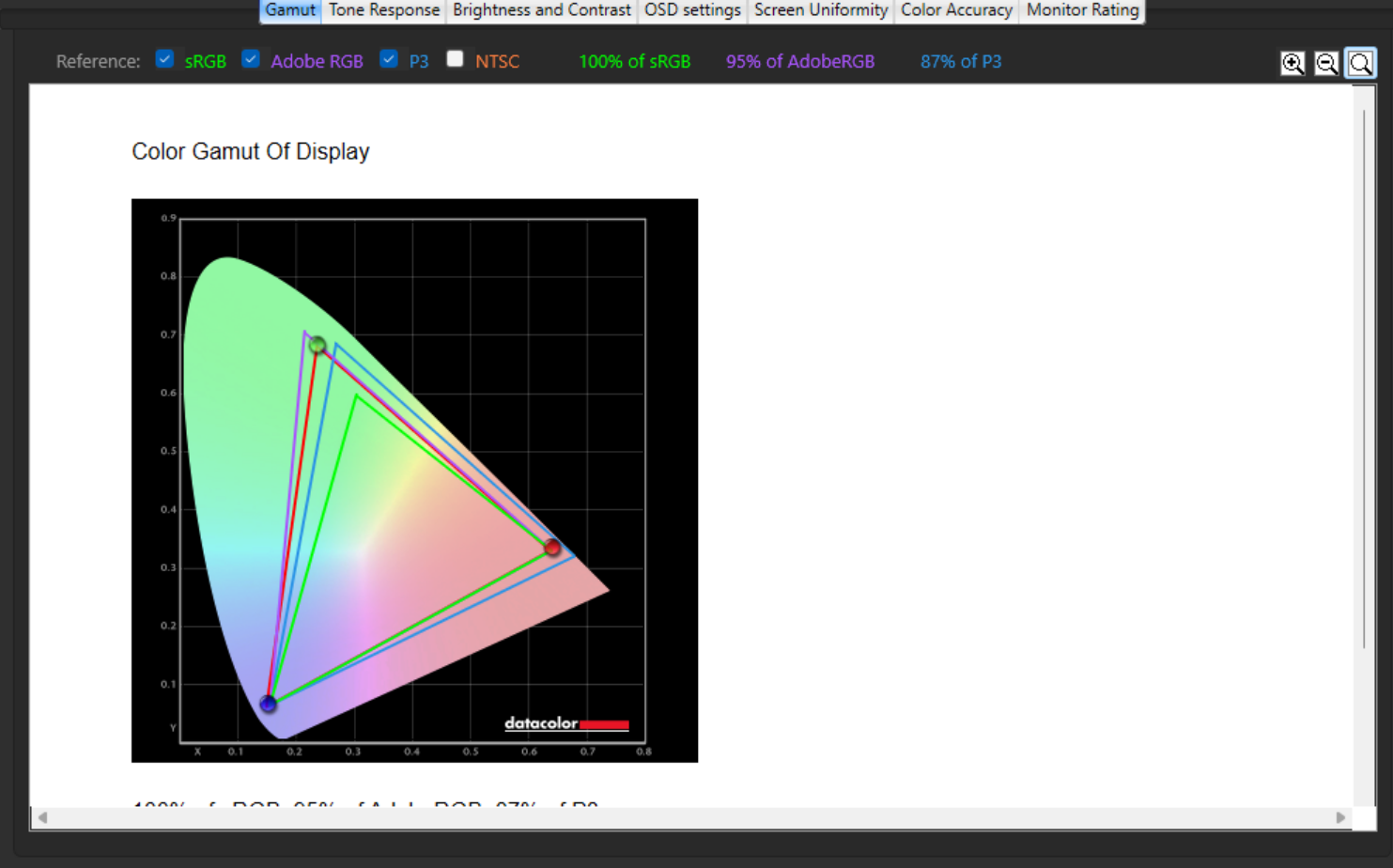
As noted above, the laptop contains both a Thunderbolt 4-equipped USB-C port as well as two other “generic” USB ports. The I/O throughput difference is profound, so thankfully Samsung etched a tiny lightning bolt logo next to the high-speed port.
The entire laptop is powered by a compact 65W USB-C charger that brought the laptop up to about 50 percent in a little more than an hour. You probably won’t be flipping back and forth between the charger and battery power that often, but when you do, there’s an annoying half-second or two when the display goes black before switching over to the new power mode.
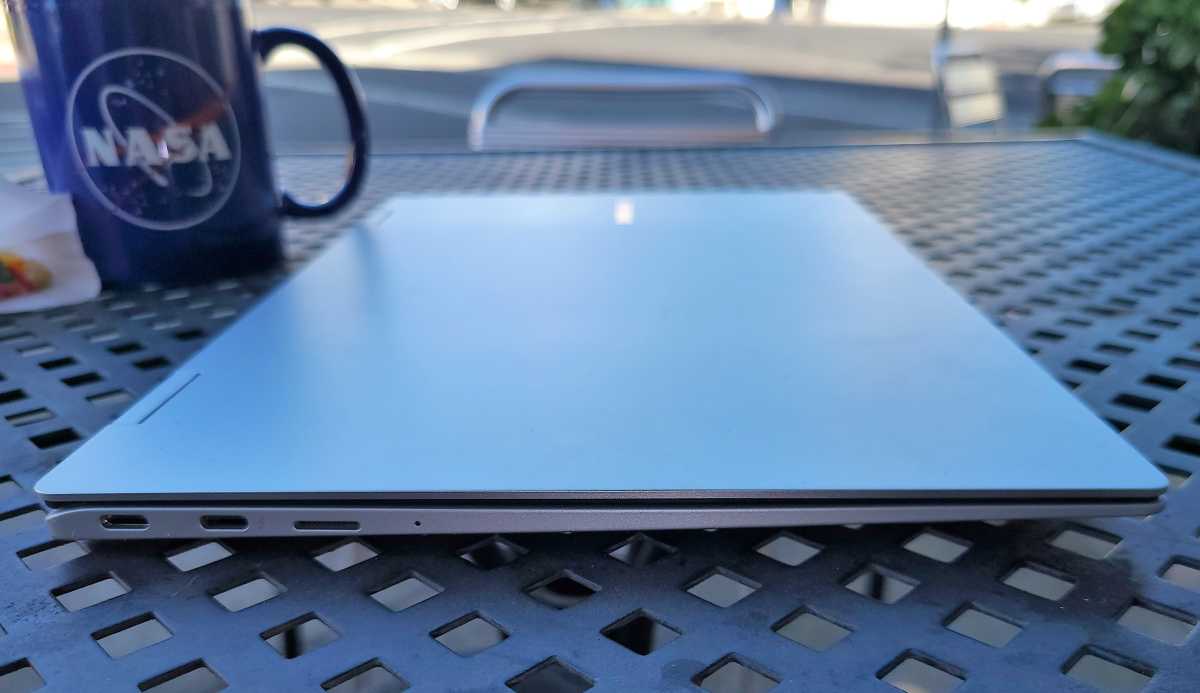
Mark Hachman / IDG
Mark Hachman / IDG
Mark Hachman / IDG
Typing experience, audio, and webcam
Samsung rates the key travel on its Galaxy Book Pro 360 keyboard at 1mm, less than the key travel on comparable devices. That’s the distance in which your fingers can depress the key before it “bottoms out.” Personally, I prefer a travel distance of about 1.5mm. But Samsung softens the blow with a series of springy scissor switches mounted under rubbery keypad domes, which helps your fingers land more comfortably. The bigger the cushion, the sweeter the pushin’, as one famous band wrote. The individual keys are also comfortably sized.
I also prefer the way Samsung laid out its 15-inch keyboard — but again, the compromises are smart. The tiny cross of directional keys in the lower right-hand corner isn’t feasible for prolonged use and the top row of function keys are small enough that they should be used only occasionally. The choices laptop manufacturers make in selecting function-key shortcuts is oddly fascinating.
The top row is especially noteworthy. The F11 key triggers performance mode and pressing Function + F10 turns your camera and mic on and off. The poor F11 key, on the other hand, does triple duty. It serves as a shortcut for both full-screen and performance mode (Function + F11), and it can also be used to launch Samsung’s “secret screen capability” (Win + F11).
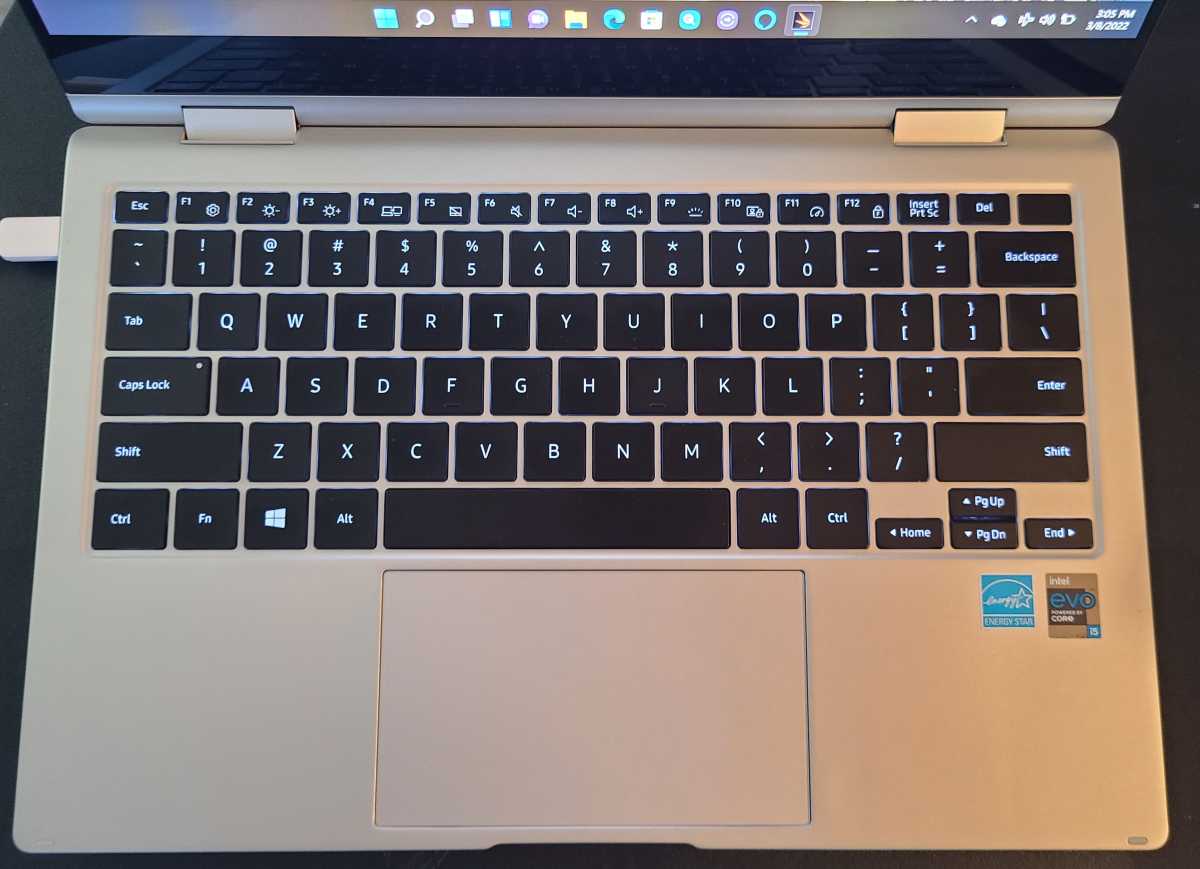
Mark Hachman / IDG
Mark Hachman / IDG
Mark Hachman / IDG
Keep in mind that Samsung tucks its Windows Hello fingerprint reader under the power switch to the upper right-hand-corner of the keyboard. Samsung’s sensor still earns a mediocre grade, often failing to identify my finger until I tapped it several times. Make sure you have a PIN set within Windows. (You can’t log in using the user-facing camera, unfortunately, as it’s not Windows Hello certified).
As far as the camera is concerned, I still favor a higher-resolution 1080p camera than the 720p user-facing camera Samsung included instead. The camera should capture your face well with accurate color and lighting, but the low-res camera simply won’t do you any favors on Microsoft Teams or Zoom. Samsung’s F10 shortcut, mentioned above, serves as the only shortcut to turn off your mic and camera, as there’s no privacy shutter.

Mark Hachman / IDG
Mark Hachman / IDG
Mark Hachman / IDG
On the other hand, the included “beauty settings” that accompany the camera have less work to do — about the only noticeable change they offered were to erase circles from under my eyes and slightly slim my chin.
The Galaxy Book Pro 360 5G delivers crisp sound of moderate volume from a pair of speakers, tuned by AKG. Really, they offer about as much as you’d hope they would. Music and movies sound great at both the high end as well as the midrange. The low-end tones aren’t as robust as you might like, but a thin laptop doesn’t offer all that much to work with. I couldn’t find an audio equalizer in the included Realtek audio app, though the upcoming revamp to the Windows Media Player should supply one. My only complaint is that I’d like the two speakers to deliver a bit more oomph.
An excellent inking experience
As with the 15-inch model of the Galaxy Book Pro 360, the smaller 5G model doesn’t provide any place to store the included S Pen, which can be used for either drawing or as a control mechanism via its single button. You can magnetically attach the Pen to the back of the laptop’s screen (weakly near the bottom or more strongly near the top), though you should expect it to immediately lose it in the bottom of a backpack.

Mark Hachman / IDG
Mark Hachman / IDG
Mark Hachman / IDG
Fortunately, the S Pen doesn’t require charging or pairing, as it uses a Wacom technology called EMR to ink on the screen’s digitizer. Samsung has demonstrated impressive inking capabilities, both on our first look at an early Galaxy Tab S8, and now here on the Galaxy Book Pro 360 5G as well. Three factors usually determine the inking experience: the time it takes for the ink to “flow” from the pen, any ink offset from the nib, and any jitter that occurs while the pen is inking. The first metric is simply any lag that occurs as you quickly move the pen across the screen and with the Samsung S Pen it was noticeable but minimal. The S Pen’s interaction with the digitizer is flawless when inking horizontally, as the ink emerges directly under the nib. It’s slightly offset when inking vertically.
Normally, when slowly inking a diagonal line with a ruler, there’s still some jitter, resulting in an unintentionally wavy line. There’s hardly any at all with the Galaxy Book Pro 360 5G, making it one of the best inking experiences around.
5G mobile experience
Naturally, one reason to buy this laptop the optional 5G WWAN option. Samsung provided us a test SIM to facilitate testing. Keep in mind that a true mobile laptop experience is one part battery, one part SIM, and one part display — Samsung seems to have nailed this.
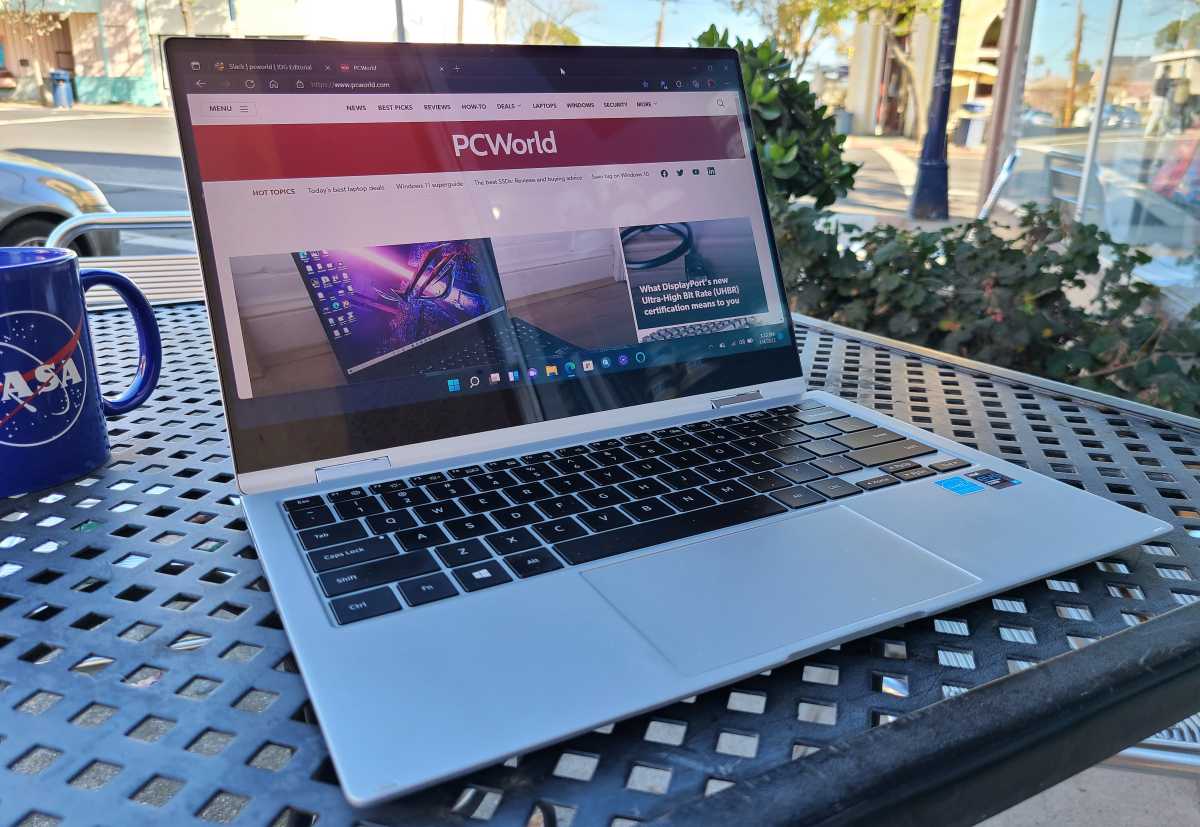
Mark Hachman / IDG
Mark Hachman / IDG
Mark Hachman / IDG
Though the display isn’t overly bright, it was perfectly fine for working outside my local coffee shop as well as indoors — just keep to the shade. Even right by the bay, the Verizon SIM provided 40 Mbits/s down, though less than a megabit upstream. It was far better elsewhere. At the coffee shop, for example, the laptop received 80Mbps downstream and 8Mbps up. That’s perfectly fine as an alternative to a suspicious or crowded Wi-Fi access point. (The laptop’s Wi-F 6E is the most advanced on the market today).
Samsung is notorious for including many of its own branded apps. You’ll find some tucked within the Start menu under the “Galaxy” name (the Galaxy Book Experience and the Galaxy Book Smart Switch, which helps migrate files from another Samsung PC) as well as “Samsung.” The latter includes apps that replicate what Windows does such as Samsung Studio Plus, which serves as a media editor.
Pay closer attention to Samsung Security, which offers a custom privacy folder, a “security cam” that emails you when someone sits down at your PC, and a “secret screen” that uses transparency effects to confuse prying eyes. Samsung Settings also offers a number of configuration options which you may find useful including a screen mode to set your PC with vivid colors and a battery protection option that can prevent your PC from charging itself fully. The latter isn’t a bug but a feature, in that it prolongs your laptop’s battery by doing so.
Performance
I wasn’t particularly impressed with the performance, especially with how laggy the SSD can be. While unzipping files, the process would halt for a few seconds, making me wonder if there was something wrong with the system. These issues have been endemic to Windows 11, but they should have been fixed by now.
So, I checked it. We usually let our standard performance tests speak for themselves, but the SSD issue was worth spotlighting. Below, we’ve compared CrystalDiskMark 4.0.3 results between the Microsoft Surface Laptop Studio and the Book Pro 5G. Are they direct competitors? No. But even if you don’t understand which tests govern what, you can see that the read and write performance of the Surface Laptop Studio are generally much higher than the Samsung laptop. It’s a hidden weak point.
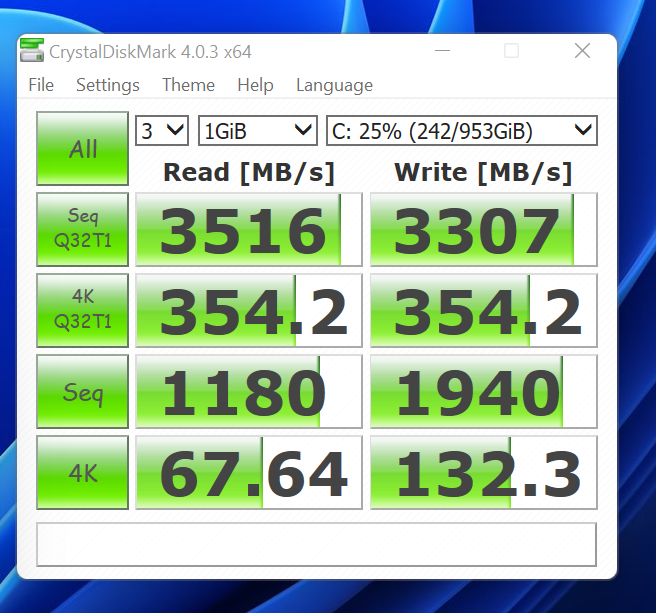
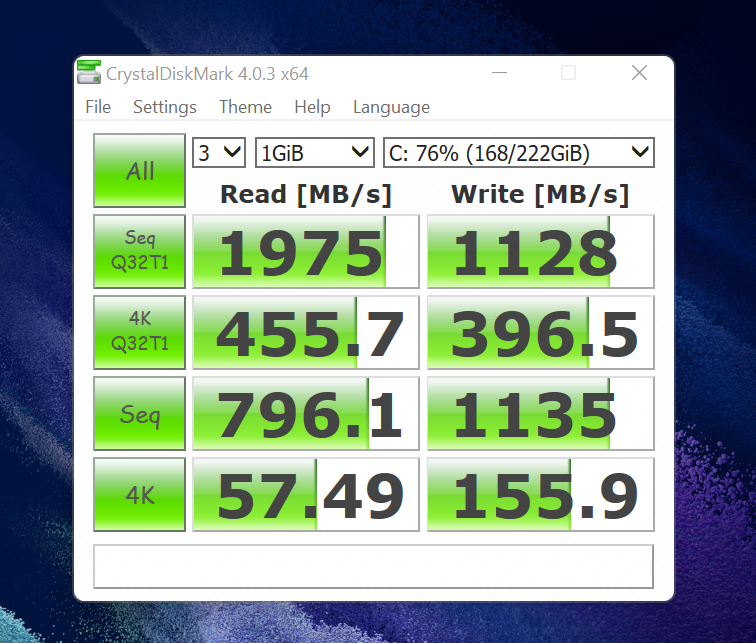
In other tasks, however, the laptop performed more impressively. YouTube playback of a 4K/60 stream streamed without a single frame being dropped on the native 1080p display and just 17 out of 10,000 on an external 4K display. That’s excellent and you won’t notice any jitter playing back videos. Modern browsers also accommodate systems with low memory well, so you should be able to open numerous tabs without any slowdown. Still, our synthetic benchmark results weren’t impressive.
We’ve chosen to compare the Samsung Galaxy Book Pro 360 5G to the 15-inch Samsung Galaxy Book Pro 360 as well as other similar devices such as the 13-inch Surface Pro 8 and the Dell Latitude 7320 Detachable tablets, the HP Elite DragonFly Max and Lenovo ThinkPad X1 Nano business notebooks, plus the Razer Book 13. (We also added the unreviewed Huawei Matebook X Pro, which isn’t being sold in the United States). Ideally, the Samsung convertible would deliver competitive performance and outstanding battery life, but it falls well short in several areas.
There’s a reason for why it falls short and it’s hidden in the PCU’s model number. The Galaxy Book Pro 360 5G is powered by a Core i5-1130G7, one of Intel’s “UP4” class of Tiger Lake processors. That’s code for a tablet-class processor, signaled by the “0” at the end of the number. More powerful “UP3” processors for mainstream notebooks have a “5” at the end of the model number. Those processors demand more power (15 to 28 watts) versus the 7 to 15 watts UP4 chips like what’s inside our review unit. Here’s the upshot. Performance will suffer, though battery life should improve. We see this in the results below.
Our benchmark suite begins with UL’s PCMark 10, a general-purpose test that evaluates a PC on several fronts like web browsing, video calls, CAD work, and more. The benchmark is designed as a comprehensive evaluation of all of a laptop’s merits, though we’ve obviously added to it with our other tests. Remember, we’re testing a Core i5-powered tablet-class laptop against a number of Core i7-powered machines. Most of them perform quite similarly in this test.
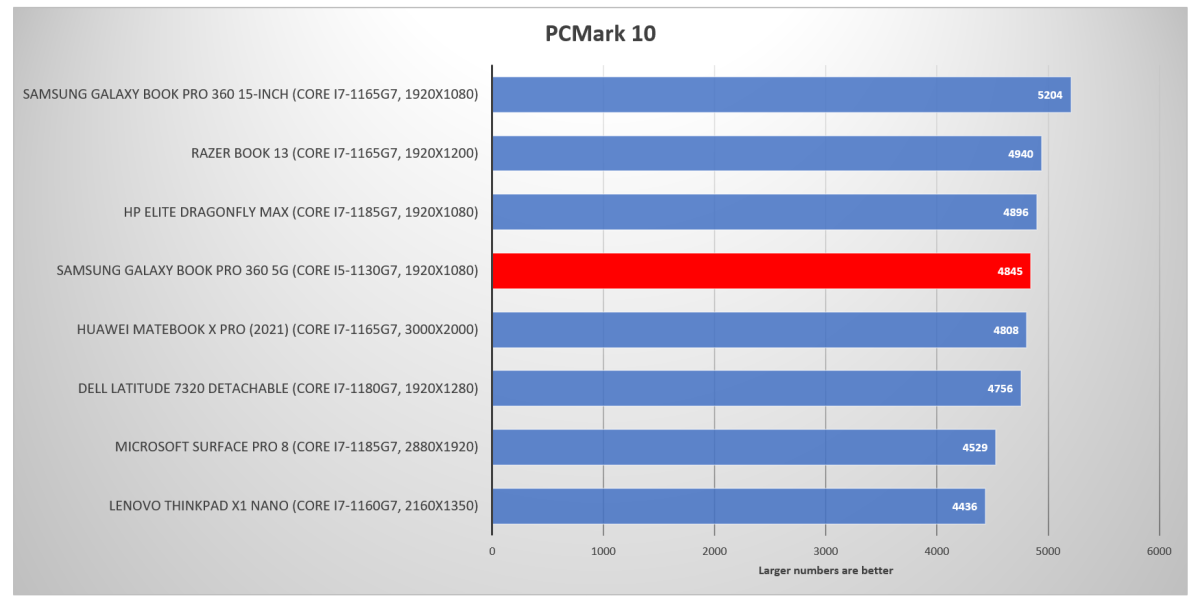
Mark Hachman / IDG
Mark Hachman / IDG
Mark Hachman / IDG
We’ve maintained the use of Cinebench R15, though modern laptops complete this bursty test quite quickly. Cinebench is designed to show how well a laptop responds to a generic CPU-driven task that falls outside of the chores put to it within the PCMark test. The Galaxy Book Pro 360 5G performs surprisingly poorly here, even though the processor is a tablet-class chip. The ThinkPad X1 Nano and the Dell Latitude 7320 outperform it fairly handily. Even running the laptop in its “maximum performance” mode didn’t move the needle at all.

Mark Hachman / IDG
Mark Hachman / IDG
Mark Hachman / IDG
Handbrake is a real-world application used for transcoding video, which can take an hour or more to transcode a full-length movie into a format that’s appropriate for toting along on an Android tablet. We use this test to measure how well the Galaxy Book Pro 360 5G performs under prolonged load. Of all the tablet-class processors, it performs the best.
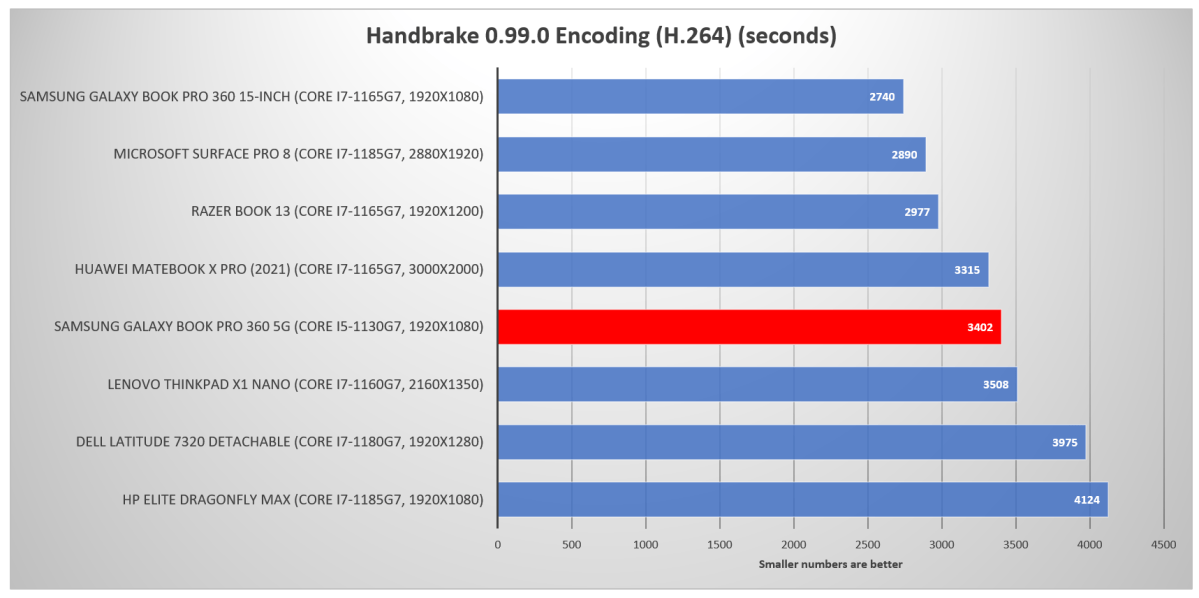
Mark Hachman / IDG
Mark Hachman / IDG
Mark Hachman / IDG
We’re not expecting you to use the Galaxy Book Pro 360 5G to play games on and our 3DMark test bears that out. We use the modern “Time Spy” benchmark here and the results aren’t anything to speak of. Instead, you could use the device like a Chromebook to play games on it from Xbox Game Pass or another service. The key here is that you’ll want to play most modern games in the cloud, not on the local PC.
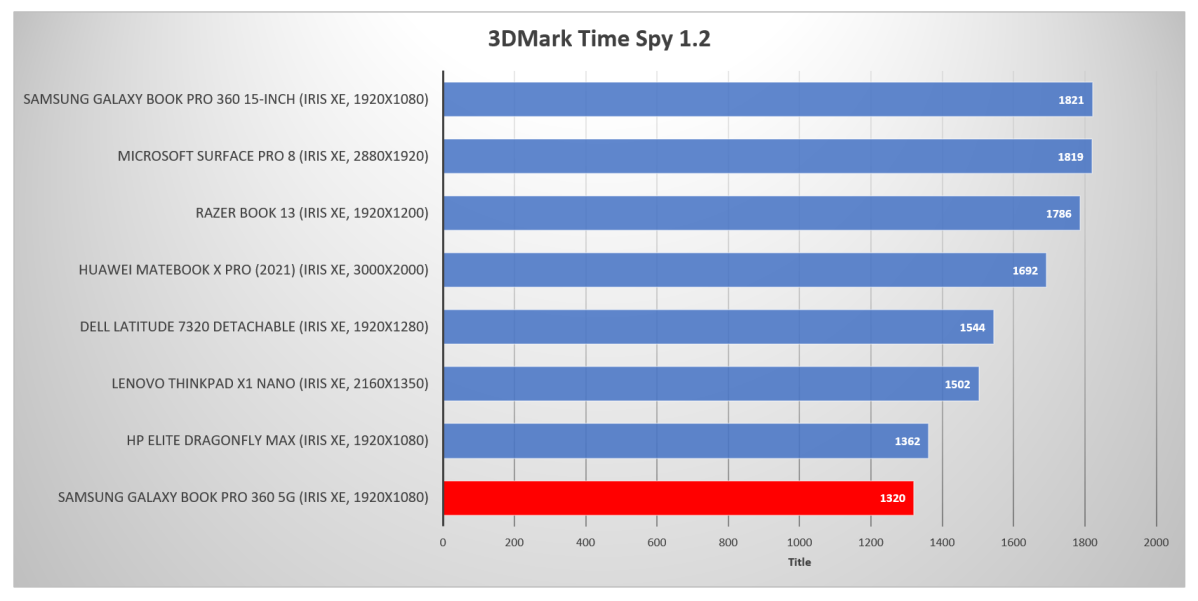
Mark Hachman / IDG
Mark Hachman / IDG
Mark Hachman / IDG
Battery life, though, is where we’d expect this thin laptop to shine and it does. In our roundup, the only laptop that outperforms it is its bigger brother. Incidentally, almost 16 hours of battery life pushes into the range of laptops that use Qualcomm’s battery-sipping Snapdragon chips, as evidenced by the battery-life chart that accompanies our HP Elite Folio review.
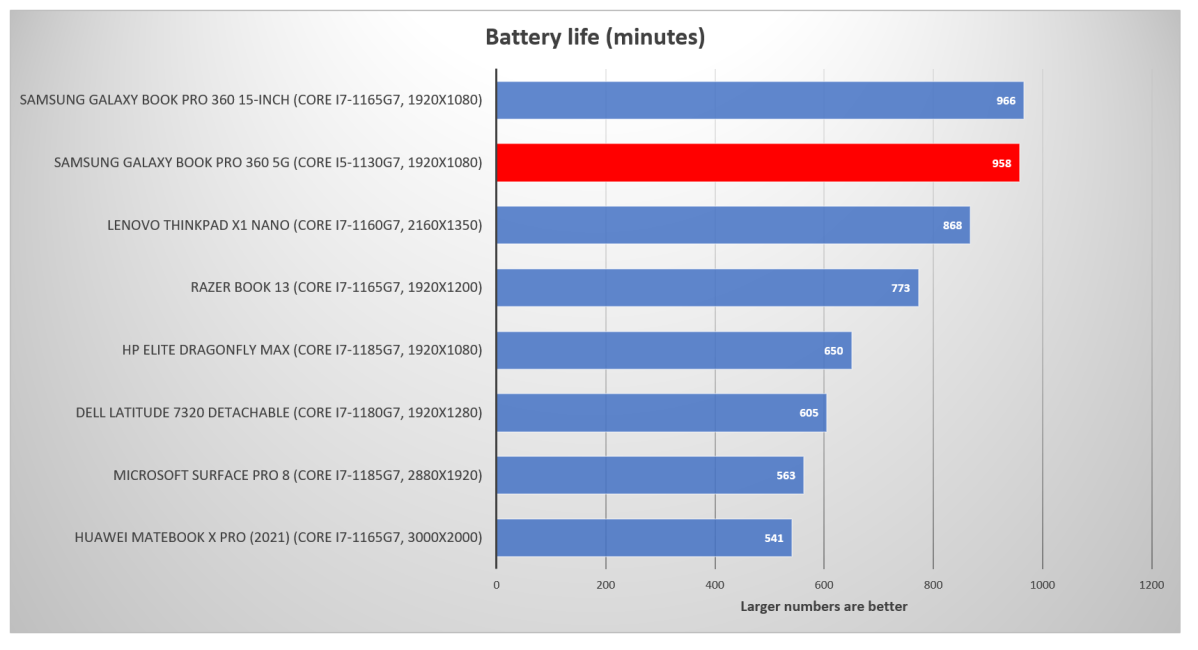
Mark Hachman / IDG
Mark Hachman / IDG
Mark Hachman / IDG
Conclusion
The Galaxy Book Pro 360 5G is less like a traditional laptop and more like a convertible, connected tablet. Sure, it’s not as light as or as thin as a traditional tablet like the Surface Pro 8 nor is it as powerful as a more traditional clamshell. But if you like it offers, you might consider the 15-inch Galaxy Book Pro that we separately reviewed.
In fact, you might consider this review as a jumping-off point for what you’d really like in a laptop. More performance? Well, inevitable discounts might spur you to buy the Core i7 version of this machine. However, performance should only increase rather marginally. Other business notebooks offer competitive features and they’re worth a look.
Our review, though, probably underscores what makes this laptop a must buy for a certain niche. At a little over $1,200 and with the possibility of more discounts to come, this convertible is both lightweight and connected. Samsung’s OLED screens are simply lovely for watching videos upon and the 360-convertible form factor does allow for a tablet-like experience in this new era of Android apps on Windows. Finally, this laptop delivers marvelous battery life and a 5G connection to boot. From that perspective, the Galaxy Book Pro 360 5G has a lot to offer.
Best Prices Today: Samsung Galaxy Book Pro 360 5G
RetailerPrice
Author: Mark Hachman, Senior Editor

As PCWorld’s senior editor, Mark focuses on Microsoft news and chip technology, among other beats. He has formerly written for PCMag, BYTE, Slashdot, eWEEK, and ReadWrite.
Recent stories by Mark Hachman:
Apple claims its M4 chip’s AI will obliterate PCs. Nah, not reallyWindows’ AI-powered future could feature ‘Qualcomm Inside’Google’s best AI editing tools are coming to Chromebooks, not PCs



